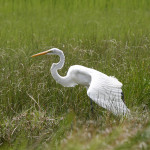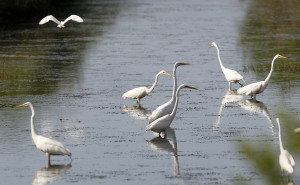• • •
Great Egrets have a long, thin neck and strong, tapered bill ideal for striking at prey from a distance. They feed mainly on fish in ponds, marshland and quiet surf along the shoreline, stepping slowly and deftly through the water and heavy vegetation.
• Length: 39 inches
• Wingspan: 51 inches
• Season: Year-round
More about Great Egrets.
Where they are, and when.
The Great Egret’s diet is mainly small fish, but they also eat frogs, lizards, snakes, crawfish, shrimp, insects and even small mammals.
They usually nest in colonies with other herons, ibises and cormorants. Their nests are loose platforms of sticks in tall trees and occasionally in heavy cattails closer to the ground. They lay up to six pale blue-green eggs.
I’d never seen more than two or three Great Egrets together, and even then they were just going about their own business. But when I crossed a small bridge over the slough at Brazoria National Wildlife Refuge, more than a dozen were foraging together, pacing back and forth across each other’s paths. There probably was a large enough school of small fish in one place that word had gotten out.






